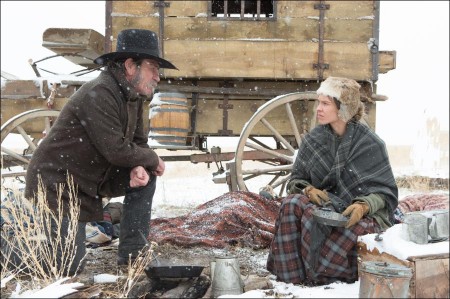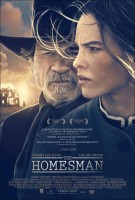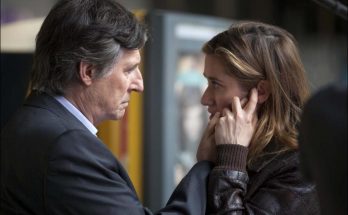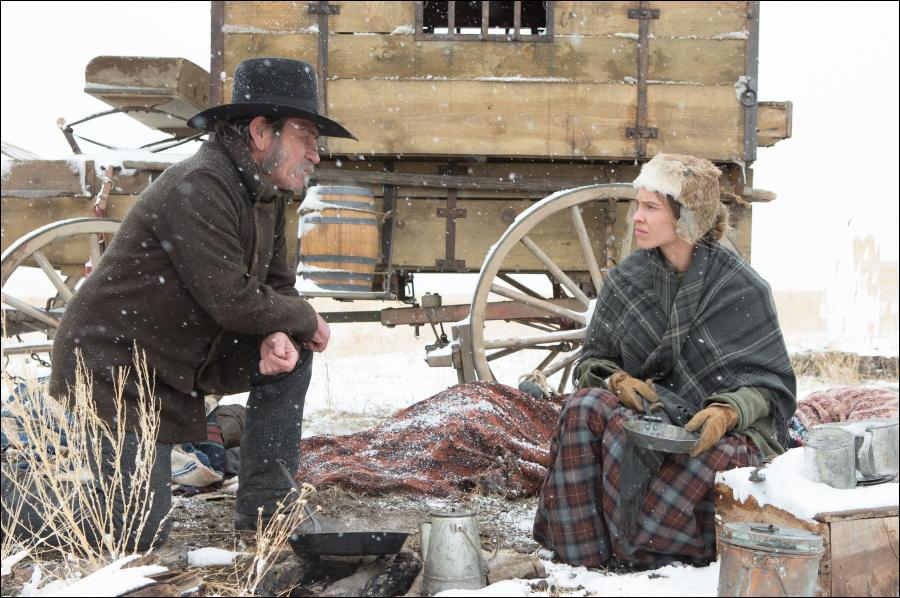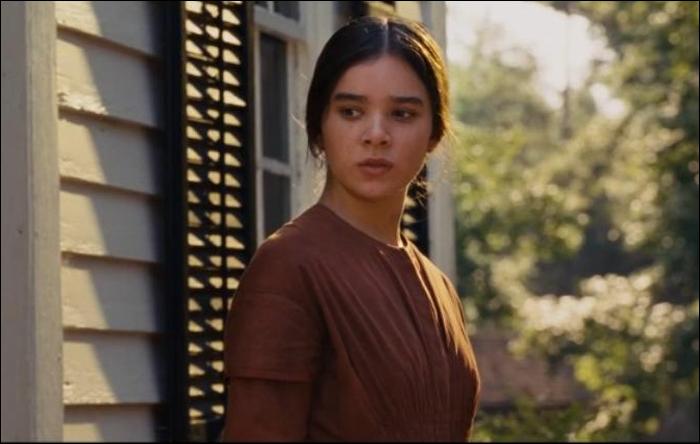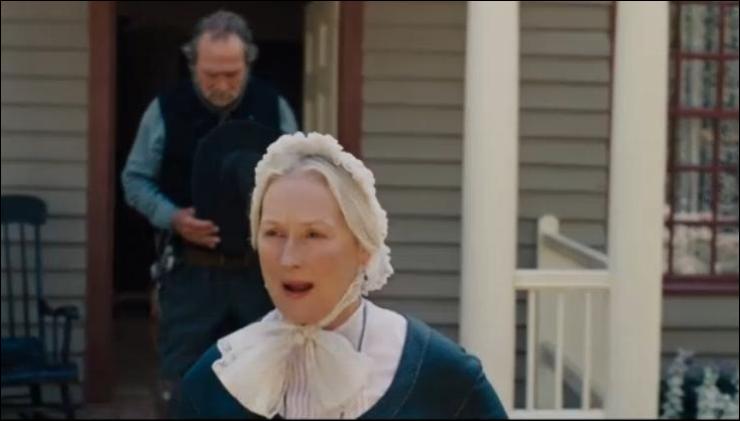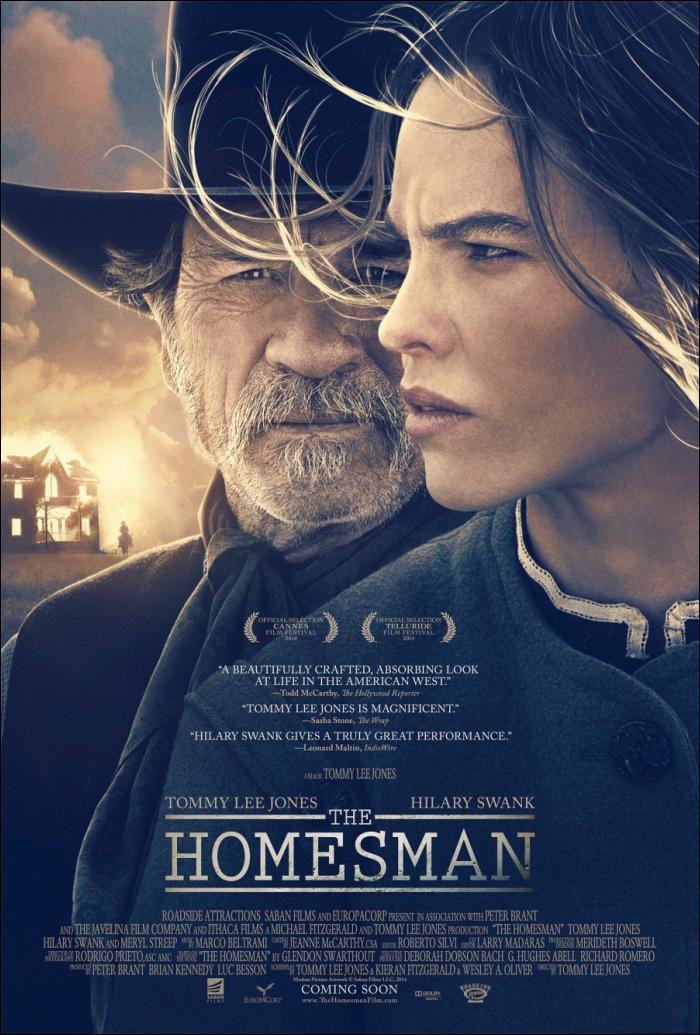When three women living on the edge of the American frontier are driven mad by harsh pioneer life, the task of saving them falls to the pious, independent-minded Mary Bee Cuddy (Hilary Swank). Transporting the women by covered wagon to Iowa, she soon realizes just how daunting the journey will be, and employs a low-life drifter, George Briggs (Tommy Lee Jones), to join her. The unlikely pair and the three women (Grace Gummer, Miranda Otto, Sonja Richter) head east, where a waiting minister and his wife (Meryl Streep) have offered to take the women in. But the group first must traverse the harsh Nebraska Territories marked by stark beauty, psychological peril and constant threat.
The Homesman is an American period drama film set in the 1850s midwest produced and directed by Tommy Lee Jones and co-written with Kieran Fitzgerald and Wesley Oliver, based on the 1988 novel of same name by Glendon Swarthout. The film stars Jones and Hilary Swank and also features an ensemble cast that includes Meryl Streep, Hailee Steinfeld, John Lithgow, and James Spader.
The film was selected to compete for the Palme d’Or in the main competition section at the 2014 Cannes Film Festival and received a North American limited release on November 14, 2014 by Roadside Attractions. The Homesman has received positive to mixed reviews from critics.
About the Production
Published in 1988, Glendon Swarthout’s award-winning novel, The Homesman, is a heartfelt and harrowing tale set in the newly created Nebraska Territories. The story of the oft-forgotten frontierswomen without whom America’s Westward Expansion would never have been possible, it is an emotional portrait of the resilient and resourceful pioneers of the American frontier, set against the seemingly endless horizon of the Great Plains.
“It’s 1855,” says director, co-writer and star of The Homesman, Tommy Lee Jones. “Three women who have been driven insane by the hardships of life on the American frontier are being transported in a wagon across Nebraska by another intrepid woman. It was important for me to explore the female condition in the mid-nineteenth century American West because I think it’s the origin of the female condition today.”
The project was brought to Jones’ attention by executive producer Michael Fitzgerald, with whom he had collaborated on his first directorial effort,The Three Burials of Melquiades Estrada. “I’ve known Tommy for a long time,” Fitzgerald says. “I hold him in a very high regard as an actor and a director, and I’m constantly in awe of his capacity to do both jobs.”
Looking for a new project to pitch to his old friend, Fitzgerald asked Sam Shepard, the writer and actor, if he knew of anything that would be suitable. “He immediately came up with this project,” says Fitzgerald. “It was something that he himself wanted to do for some years, but he’d never been able to get the rights. I agreed that it would be absolutely perfect for Tommy.”
Optioned years earlier by the late actor and filmmaker Paul Newman, The Homesman had never made it to the screen, unlike several of Swarthout’s earlier works, including the western The Shootist (John Wayne’s final film,) the contemporary coming-of-age storyBless the Beasts & Children, and the classic spring-break romp Where the Boys Are. Although the action takes place in the western half of the United States, the filmmakers are hesitant to classify The Homesman as a western.
“I don’t know how you define the term western,” says Jones. “I have the impression that a western is a movie that has horses in it and big hats and that takes place in the 19th century on the west side of the Mississippi river, although I’ve read critics who are bold enough to call a science-fiction movie a western. It’s a term that people use so often that I don’t think it has much meaning anymore.”
Producer Michael Fitzgerald observes that the setting of The Homesman is not the West traditionally seen in American films. “It’s earlier on, in the 1850s, whereas most westerns take place in the 1880s and ’90s. In fact, this is about life on the early frontier of the Midwest, so I wouldn’t call it a western, even though there are certain things that it shares with that genre, like horses, wagons and guns. But more importantly The Homesman is really about the way in which we can be transformed. What does it take to make a decent person? That’s the theme that moved me the most.”
When Jones teamed up with screenwriters Wesley Oliver and Kieran Fitzgerald to create the screenplay, he was shooting Hope Springs with Meryl Streep, who would become one of his co-stars in The Homesman. “In between their scenes, we would work onThe Homesman,” recalls Oliver. “Tommy would do a scene with Meryl, come across the street, work with us, go back across the street and jump 150 years forward in time into a contemporary romantic comedy. It was a remarkable achievement on his part to be able to do that and I think being around the excitement of a film already in production energized our writing process.”
The first draft was completed in an astonishing five days, the writers say. “We worked from early in the morning till late in the evening with almost no interruption,” according to Kieran Fitzgerald. “It was the most productive time ever.”
The next step was to fill in the backstories of the three women that Mary Bee must escort across hostile territory: “That was in some ways the most challenging part of the writing,” says Oliver. “In the novel, Glendon Swarthout sometimes shows results without describing the steps it took to get there. So we had to imagine background moments. We had to try to piece together in more detail what happened to these women.”
The writers began creating detailed flashbacks, or “memory hits,” as Jones refers to them. “That gave us a chance to get inside their minds and write a lot of scenes along the way,” says Oliver. “It helped clarify for us the lives they lived, the hardships they went through, and the kinds of events that would have led them to break down.”
“Each of the women broke down for a distinct and different reason,” adds Fitzgerald. “That distinguished one character from another and stayed true to real-life events.”
One of the elements that make the film unusual is that it views frontier life primarily from Mary Bee’s vantage point. “We tried to take a woman’s point of view for the story,” says Oliver. “We started that process by reviewing images of women on the frontier. Tommy had a book with a number of really wonderful photographs of pioneers and settlers in the 19th century. Many of those images became part of the cinematic vocabulary we used once we started writing.”
“The image of Mary Bee pumping water at the well in front of her house came from those images,” adds Kieran Fitzgerald. “The photographs of those pioneer women really inspired the movie.”
The resulting film is both historically accurate and relevant to today’s world. “Times have changed and customs have changed,” says Fitzgerald. “The characters in the movie have less access to healthcare and nutrition than we do, as well as to material comforts, but I think the human condition is the same. People have always suffered and they continue to suffer for various reasons. This is a look at the suffering of those people at that time in American history, which is something we have not had the occasion to explore honestly before.”
Oliver adds that the emotional and psychological isolation and alienation on display in The Homesman still loom over our modern world. “The digital age is rife with stories of people more desperate to connect than ever despite, or perhaps because of, the facility of communication today. Mary Bee’s story is very much about trying to find a connection that will sustain her soul.”
The Homesman
Directed by: Tommy Lee Jones
Starring: Tommy Lee Jones, Hilary Swank, Grace Gummer, Miranda Otto, Sonja Richter, Jo Harvey Allen, Caroline Lagerfelt
Screenplay by: Kieran Fitzgerald, Tommy Lee Jones, Wesley Oliver
Production Design by: Merideth Boswell
Cinematography by: Rodrigo Prieto
Film Editing by: Roberto Silvi
Costume Design by: Lahly Poore
Set Decoration by: Wendy Ozols-Barnes
Art Direction by: Guy Barnes
Music by: Marco Beltrami
MPAA Rating: R for violence, sexual content, some disturbing behavior and nudity.
Studio: Roadside Attractions
Release Date: November 14, 2014
Visits: 77
